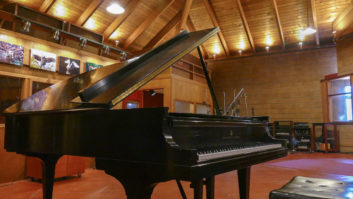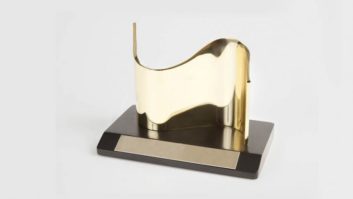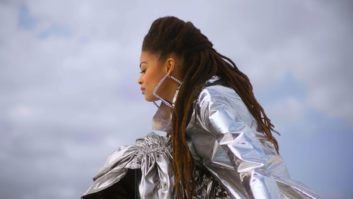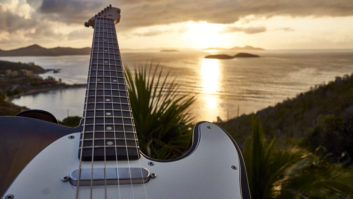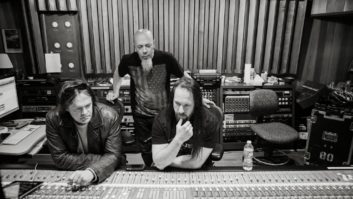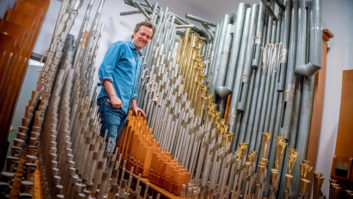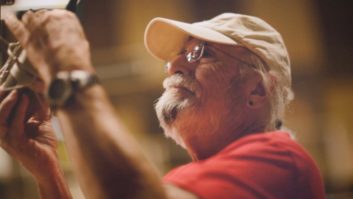This month, we turn our attention to different methods of recording brass and woodwinds. We spoke with five top engineers — Michael Bishop, Al Schmitt, Richard King, Eric Schilling and Lolly Lewis — who cover a broad stylistic spectrum to glean some specific tips and techniques to make your recordings sound as good as they can be.
MICHAEL BISHOP
As one of the principal engineers for the Ohio-based Telarc label — known far and wide for the excellence of its recordings — Grammy Award-winning Michael Bishop gets a chance to work with a wide variety of artists in many genres. His credits include many CDs with horn and woodwind sections and/or soloists, including numerous discs with the Cincinnati Pops Orchestra, the Empire Brass ensemble, the late sax great Gerry Mulligan, Dizzy Gillespie, the Memphis Horns and others. He spoke first of his experience with the Lenox, Mass.-based Empire Brass quintet.
“Fortunately, for engineers, a brass ensemble is going to have a natural blend among themselves, because they are used to coming up with that in a live situation. As an engineer, I want to take advantage of that skill that they have, because, in a sense, I could never mix them the way they’re going to mix themselves. They’re accustomed to playing to the house.
“I’ve done many records with the Empire Brass quintet, and that has varied from a straight brass quintet to a brass quintet with percussion, brass quintet with rhythm section, with synths, with orchestra; all sorts of things. The one thing that doesn’t really change over all those situations is what I do with the quintet. We work in an acoustic environment that’s suited to the music, and which can contain the sound of a brass quintet, which can be quite loud. You don’t want too bright a room; you don’t want slap. You want a good, warm sound. The room needs to be able to support French horn and tuba without becoming muddy, and that can be difficult. And if it’s too bright, the trumpets become overbearing. Trumpets cut through everything like a laser!
“With an ensemble like this, I’ll usually set up an RPG [diffuser] wall behind them in a big semi-circle, eight to 10 feet tall. The group is in a semi-circle, too, so they can have some eye contact. I’ll turn the French horn slightly around backward so I’m getting a bit more of the direct sound of the bell rather than indirect; that works better and makes it sound a little more punchy. And I’m typically miking with just a stereo pair over the group. Traditionally, I’ve used a pair of Sennheiser MKH20s, typically anywhere between 12 to 24 inches apart and a good 15 to 20 feet from the group. The height will vary, but it will usually be around eight feet off of the floor. Lately, though, I’ve been using the Neumann KU 100 binaural head with very good results. In the past, I was never really one to subscribe to binaural recording. I thought it was interesting but never very practical, since most people will be hearing it over loudspeakers, not headphones. But one of the features of the KU 100 is that it’s loudspeaker-compatible. The one thing you lose on speakers is the sense of height that the [binaural] head can give you on headphones, and you don’t get the behind-you effect. But I use them because the stereo imaging is so good and so accurate, and tonally it works and it can handle the level of a brass quintet. If I don’t have the head, though, the MKH20s work great.
“With the Empire Brass, we record directly to the master, and all we’ll do later is edit. So any blending I do is by moving the guys a bit here and there and also altering the RPG diffusers, because I can reinforce certain parts of the group by moving the diffusers around. So my chain for that kind of recording would be the mics into a Millennia Media HV-3 preamp, which I’ll have right there at the base of the microphone, straight to the A/D converter, which currently is all Direct Stream Digital — the custom Meitner converter — feeding a Genex 8500. Those all work great as an in-the-field combination; it’s nice and convenient.
“However, these days we don’t do much that’s only straight-to-stereo; we’ll do a straight-to-surround, too. For the surround, I don’t just augment the stereo pair; in fact, the stereo pair doesn’t even exist in the surround version. On a brass quintet, I’ll go with a pair of Sennheiser MKH50s, which are supercardiods, pretty much in the same spot as the two omnis I’d be using for the stereo version, so it’s the same perspective. Only now I’ve removed a lot of the room out of the pickup, but I’m getting the same balance across the group. And I’ll add to that, in a relatively simple setup, a pair of MKH30s — the bidirectionals — as the surround pickup further out into the hall. And they’re not that far away; maybe 10 to 15 feet behind the main front pair.”
Usually the brass cuts through fairly well, but occasionally the low tones sort of wander around the hall, and you don’t get enough impact to have the guts to it that people want.
— Michael Bishop
On working with brass in a larger orchestral setting, Bishop comments, “Usually the brass cuts through fairly well, but occasionally the low tones sort of wander around the hall, and you don’t get enough impact to have the guts to it that people want. Certainly there are times you want a more diffuse sound, and you don’t want the brass to overpower everything. If I need to reinforce the direct sound a little bit, I’d rather do something acoustically onstage for them or adjust the shell. Putting mics back there will cause time delay and imaging problems relative to the main orchestral microphones.”
Telarc has also established itself as one of the top contemporary blues labels, and Bishop has worked with some of the genre’s best. On a CD he made with Son Seals last year, Lettin’ Go, Bishop got to record with the horn section from the Conan O’Brien show, and, not surprisingly, that called for a different approach to recording horns.
“They were terrific,” he says. “They are so tight, but they are accustomed to each having a microphone, and [on TV] they play to a mic that is right in front of them, and they are accustomed to the engineer getting the blend for them. So you have to throw out any ideas of miking them as an ensemble, because it doesn’t work, and, usually, in a relatively small studio, you don’t get the proper blend anyway.
“On something like that, I’ll do fairly typical close-miking. Where there’s a departure from some of my colleagues is that I’ll tend to use the Sennheiser MKH20s, which work really great in an up-close situation, as long as you use the mic’s output attenuation to knock the level down by 10 dB. You don’t want to blast out the front end of the console or mic preamp — the Sennheisers are very high-output microphones. But I like using the omnis so I don’t have the proximity effect. Using the omni I can get good coverage on something like a saxophone, where the sound really comes out across the whole body and not just the bell, better than if I use a cardioid microphone. Same goes for trombone; there’s a lot of sound coming from any brass instrument that’s not just coming out of the bell, so you want to get that round but present sound as you can. On that Son Seals record, the microphones were typically two to three feet away from each instrument, and I really didn’t care much about the bleed because with a group like that, I had to do very few punches and I didn’t need the isolation. They were in an iso room playing live with the rest of the rhythm section.
“Woodwinds aren’t much different,” he continues, “because they have the same sort of polar patterns [as brass]. You’ll have certain frequencies coming out of the obvious place, which is the bell, and then there are the sounds that are coming out across the whole body of it, which is often where the warmth of the instrument is. So if you just stick a microphone down at the end of the clarinet, you definitely have the ‘strangling goose’ effect. So, again, I don’t get up too close. In general, I’d say that I mike things a little more distantly than a lot of engineers. I like a broader pickup rather than getting too microscopic. In an orchestral setting, the winds are often not miked. When they are, it’s with a pair of Sennheiser, Schoeps or DPA omnis about 12 feet overhead.”
AL SCHMITT
One of the most respected veterans in his field, multiple Grammy-winning engineer and producer Al Schmitt continues to have a rich and vital career four decades after getting his start. He has worked in every recording situation imaginable, from rock bands to large orchestras, and he has a credit list that stretches from here to Bora Bora, including (to name just a few) Jefferson Airplane, Jackson Browne, Barbra Streisand, Henry Mancini, George Benson, Steely Dan, Toto, Frank Sinatra and Al Jarreau. When we caught up with him recently, he was still glowing from his latest project, recording Diana Krall’s forthcoming album, Dancing In the Dark, with the London Symphony Orchestra at Abbey Road Studios.
“It was wonderful!” the ever-enthusiastic Schmitt relates. “We were in the room The Beatles’ used. We had 53 pieces, including strings, woodwinds, French horns and tuba, on analog multitrack. I’m a pretty traditional guy when it comes to recording orchestras, so we did the Decca tree [three mics on a pole near the conductor’s spot] and used the new Neumann M150s, which are fabulous. Then, I also had a couple of wides, and for those I used old M50s, another great microphone. I had spot mics, too. On the woodwinds, I used two [Neumann] U67s off about six feet, and for the French horns, I used M149s. Really, what you have to do with French horns is make sure the conductor has them under some sort of control. If you need less of them or if they’re over-blowing, you get the conductor to get them to play a little softer. I use an M49 in front of them and get a reflected sound; that’s how that instrument is meant to be heard. Sometimes you’ll put it in the back; it depends on what the arranger has in mind and what kind of sound they’re looking for.”
We go for a tighter sound on the individual instruments so we have the flexibility. But we also still put up the ambient room mics to get the fatness that we need.
— Al Schmitt
Schmitt says his overall approach and mic choices for brass sections haven’t changed much over the years, though having more tracks to work with has increased his options. “Twenty years ago, if I had a section with four trumpets and four trombones, I’d have two mics covering the trombones and two mics on trumpets; now, we use mics for all of them. We go for a tighter sound on the individual instruments so we have the flexibility. But we also still put up the ambient room mics to get the fatness that we need, and, frankly, a lot of times I won’t use that much of the spot mics; it all depends.
“For the mics, I still use the same mics I’ve been using for the last 30 years — the Neumann 67 and the M50s — and I’ll use the new M149s and the new M150s when I can; those are great mics. But I still go to the old standbys. Some people like to use ribbon mics on brass and will go with an [RCA] 77, but I’ve never used those much. If I’m going to use a ribbon mic, I’ll use the new Royer — the SF-1; that’s fabulous, too. For most brass, though, I’ll use 67s and keep them in omni. I’ll also use 67s on trombones. For sax, I like the M149.”
Schmitt stresses that on orchestral dates, it’s vital to have good communication with the conductor, whenever possible discussing an approach to the recording before the tape starts rolling. “The really good conductors will get a balance in the room for themselves, and once they’ve got that, it makes life so much easier for an engineer. You’re trying to capture that balance,” he says. “I’ve found that conductors used to be more open to discussing levels for recording; they’re not as much anymore for some reason. Still, in every case, you’re in there trying to make the best record possible so everybody should be working as a team. If you ask the conductor for something — like to bring up a section of the orchestra a little — usually they’re glad to do that.”
RICHARD KING
Richard King is a top engineer and producer who works at Sony Music Studios in New York. His resumé includes dozens of classical projects, ranging from small chamber groups to orchestras to modern ensembles. He’s done jazz dates and the Mormon Tabernacle Choir. Two of his most impressive recent achievements are the soundtrack for the Oscar-winning score of Crouching Tiger, Hidden Dragon (which he recorded in China) and Bob Belden’s moody Black Dahlia (see June “Cool Spins”), which is sort of a “Rhapsody in Blue”-meets-Kind of Blue fusion of live orchestra and jazz soloists.
Like most classical music recordists, King liked to get a good overall sound using just a couple of mics in a good, ambient setting. “My main pickup is usually a stereo pair right over the conductor, though sometimes I’ll use three mics. I like B&K 4009s, which are 130-volt omnis that are matched at the factory throughout production. Also, lately I’ve been using a pair of 4053s, which is the same capsule, but it’s on a Colette-type cable, like the Schoeps system, which is good for hanging — the mic preamp is actually in the connector, so the diaphragm is sort of out there on its own. What Schoeps did was they separated the preamp body of the microphone from the capsule and then, depending on what cable you use, you can have 15 feet between the actual capsule and the mic preamp body, so in terms of hanging them for a video shoot, you don’t have this big mic body there; it becomes more invisible to the eye.
“So I’ll have two mics over the conductor, maybe four feet apart. Then I also do a wider pair of omnis, which some people call outriggers. Both systems I pan hard left-right, and by the amount I mix of the two pairs, I can make the whole image wider or narrower. The wider pickup I’ll use different mics, and that also allows me to mix two different colors. Quite frequently for the wider pickup, I’ll use the Schoeps MK2 omni. Sometimes I’ll use the AKG C-12VR in the omni pattern. From there, I introduce other mics, just in terms of focusing.”
King has a large selection of preamps to work with, including boxes from Millennia, Sonosax, Jensen-Hardy and Mastering Lab. “What I use depends totally on what kind of room I’m in and the sound I’m going for, and that will vary from project to project,” he notes. “The differences between them are in timbre mostly. The Sonosax has a little more reach and it’s brighter and faster than a Jensen, for instance, and the Millennia is somewhere in the middle of those two. So it’s a color thing. If I’m in a room with a bright stage sound, I may not go with the Sonosax because it might be too bright. It’ll be perfect for some other situation. I don’t really have favorite preamps for different instruments, though.”
For recording brass and woodwinds in an orchestral setting, “I’m relying on the conductor to balance them overall,” he says. “What we end up doing is fine-tuning the balance. We can’t actually make things louder or softer necessarily, but we can focus things in terms of the clarity of the picture. But the basic volumes of the sections are locked in by the main pickup. Then we can focus on specific sections by introducing a closer microphone. You can make it louder that way, but you’ve also brought it right to the front of the soundscape, which destroys the natural perspective created by the main pickup, so you have to be careful.
“When I’m recording brass in an orchestra, I rely on their basic sound coming into my main mic, which gives them that nice, distant sound and a good balance, and then I would have spot mics for each section — trumpets, trombones, tuba — just to add clarity or a slight amount of presence. For the spot mics, I like the Neumann TLM170s. I’ve also recently been trying a TLM103, which is a fixed cardioid, on brass. TLMs are nice because they never come out too bright, which is good for brass in classical music; you get a fair amount of body. On some softer passages, I might use a little [of the spot mics] so a featured instrument doesn’t sound too diffuse.
“For woodwinds with orchestra,” he continues, “I’ve done two systems. One is a stereo pair, because woodwinds are relatively easy to cover with a stereo pair and you can introduce that to your mains, and it all makes sense image-wise. And the bleed from the percussion behind the woodwinds is nice, as well. For instance, I like when I open up my woodwind mics to have the timpani dead-center behind the woodwinds, because it gives a nice stereo image of the timpani, but it’s less diffuse than how the timpani is imaging in my main pickup, which is obviously much further away. Other times, if I’m mixing live, for instance to have more control, I’ll actually mic each section, with a separate flute, oboe, clarinet and bassoon mic to get a quick balance. I use Schoeps MK4s on all the woodwinds. But if I’m doing a stereo pickup of the section overall, I like the B&K 4011, because it’s a wider cardioid and it has a more even pickup of a larger group.”
I’m relying on the conductor to balance them overall. What we end up doing is fine-tuning the balance. We can’t actually make things louder or softer necessarily, but we can focus things in terms of the clarity of the picture.
— Richard King
As for placement specifics for woodwinds, “You need some distance, obviously. On a clarinet, if you go for the bell, you don’t get an even pickup of the instrument — some notes sound covered, others are too direct. I like to get a few inches closer to an oboe than a clarinet. Flute can be a little tricky. I find that if you’re too far up over the top of the instrument, you get too much of the breathy sound and not enough of the real core of the sound. And bassoon, again, coming up over the instrument, you get too much reed and not enough of the fundamental, so I’m lower in my bassoon pickup than the other instruments; lower and from the side.”
Working at Sony Music Studios, King records almost exclusively on digital media, either the Genex, which is used primarily for 2-track recordings or 6- and 8-track chamber projects, or the Sony 3348 HR. “We’re now running quite a lot of the sessions with the DSD [Direct Stream Digital] system. The Sonoma is this recorder/editor/playback system that has onscreen automation, and that’s been very reliable for 8-channel recording and editing.”
King adds, “When I build my mix, I start by listening only to my main mics, and then I’d say 90 percent of the time I end up bringing woodwind mics in at some static level all the time, even if it’s only at -20 on a fader, as opposed to the mains sitting at zero. But then, across the board, I might have three of the spots at -20, but I’ll have the oboes up at -18 or nudged up slightly higher, just to get a more even balance of the section. It’s not so much for how the instruments produce sound; it tends to be from orchestra to orchestra. Some sections are louder than others. You might have a section where the flutes aren’t as strong as the other sections in the orchestra. There might be one that doesn’t have a strong French horn section, so you end up supporting them a little more throughout. Every project is different, obviously, and what works with one orchestra or group might not work with another. That’s part of what keeps it interesting and challenging.”
ERIC SCHILLING
No discussion of recording horns would be complete without talking about Latin music. Engineer Eric Schilling has been at the heart of Miami’s Latin scene for many years, cutting more than a dozen albums with Gloria Estefan (for whom he helped build Crescent Moon studios), as well as discs with the likes of Cachao, Braulio, Azucar Moreno, Jose Luis Rodriguez and Arturo Sandoval, among others. His experience recording horns goes back much further, however — in the mid-’70s, as an engineer living in the San Francisco Bay Area, he cut tracks with Tower of Power and other horn-heavy groups. Today, Schilling lives in Orlando, where he works often at Transcontinental Studios, but still frequently commutes to Miami to work on various projects at Crescent Moon, Hit Factory/Criteria and other facilities. When we spoke, he was working on a DVD for Gloria Estefan.
With Tower of Power in the ’70s, Schilling notes, “You’d put up a mic for each horn player — there were five guys — and you’d use a lot of tube stuff and ribbons. I was really amazed that by picking the right mic and having great guys playing, there wasn’t much you needed to do to the horn mics, and I still find that to be true. In those days, we used 77s on trumpets, 87s on saxes and a 47 on baritone sax. The other thing that was true then that I still do to a certain extent is you had to blend stuff to tape. You wouldn’t put it on five tracks, because you usually didn’t have that many tracks. So you were learning to balance as you went along. So the saxes you would put to one track — that would be bari and tenor and alto — and then you’d put the trumpet to one track, and then you’d do the trumpet and sax parts twice, so you’d have four tracks. When you’re on 24-track, that’s a lot of tracks, so it was very common up until the ’90s for me that we were blending to tape.
“The main thing that changed when I moved to Florida and started doing Latin music is that bari isn’t a horn you use much in Latin music. It’s much more common to use a ‘bone in that. Trombone is usually very prominent in Latin horn sections. In R&B, the bari is often part of the bottom, but Latin music wants that sliding sound. But with Latin, too, you still have to have an ear for the blends. The people I work with a great deal, who play on a lot of the horn stuff in the southern part of the state, have been playing together as a group for about 15 years. It’s sax, trumpet and ‘bone; most of the dates we do are those three. At this point, they’ve played together so much that all their breathing is the same and they sort of blend themselves. But they also do interesting things like when they do a double-track, they’ll change horns so it changes the sound slightly and you get the sound of a larger horn date; that’s very smart. Their concept is it’s better to have fewer guys playing who play tighter than have more guys who are not used to playing as a group.”
As for microphones, “I’ve tried all kinds of things on sax, but I often go back to an 87, preferably a newer one rather than an older one, because they have improved them a lot,” Schilling says. “I will use a 67 when I can, but the problem with those is that it’s sometimes hard to find a good one. For trombone, if it’s going to be way up front and not part of a blend, I’ll use something like an AKG CL-414, TL-2, which is like a high-end 414. If it’s more section-type stuff, I’ll use a TLM193, because that’s a fat microphone; it’s much smoother, and I find that they blend well with other mics. For trumpet, I’ve changed a lot over the years. One mic I like a lot these days is the B&K tube mic [the DPA 4040], which is very smooth and it takes a lot of level, which of course you need with trumpets. If I don’t use that, I might use the A-T tube mic, the 4060, which I’ve started to use more on horns in general.
“I don’t like to get any closer on brass than two feet because once it gets too close, it starts to have a smaller sound. Bleed is not a problem, because they’re playing so loud; I don’t worry about that. Now, the challenge with a player like Arturo Sandoval is that he has such a loud, strong sound and he’s so bright, you have to find mics that take a lot of sound but aren’t too bright. The two I’ve used on him are a 77, which works well but you can’t get too close to it, and a 67. With either of those, though, he’s got to be back about four feet. Every player is different.” In addition to the spot miking, Schilling likes to put a stereo pair in the room, maybe 10 feet high and 10 or 12 feet back.
And a final anecdote from Schilling, on a non-Latin session: “I did a Natalie Cole project with Phil Ramone, and what Phil did on this ’60s-style tune that had a bunch of ‘bones and a bunch of trumpets, is he had each [group] of them sit around in a circle around a single omni, and his theory was that they had to make the blend. Then we also had French horns, which were off to the side and playing into a brick wall, and then we miked the wall, which is not that unusual. French horns are not really designed to be heard by your ear from the bell. Anyway, we did this whole horn date with three mics. It took the musicians a little while to adjust to this, but once we got them into that groove, it worked quite well.”
LOLLY LEWIS
It’s not easy being a classical music engineer and a producer in a secondary recording market like the San Francisco Bay Area, but Lolly Lewis has thrived there, working consistently and on a wide variety of styles, from early music to modern. Unlike her engineer brethren above, she is loath to talk about specific mic favorites of hers, insisting, with characteristic candor, “Mics — it doesn’t make a damn bit of difference. Everybody has preferences, but it’s not, in any way, the most important thing. The most important thing is the players and their instruments. You’ve got a good fiddle, and it’s going to sound fabulous if you’ve got a decent mic in a decent spot. If you’ve got something that’s too close or you don’t have a good player, there’s nothing you can do that’s going to make it sound wonderful.”
I was really amazed that by picking the right mic and having great guys playing, there wasn’t much you needed to do to the horn mics, and I still find that to be true.
— Eric Schilling
That said, Lewis will talk about her basic philosophy of miking and recording. “It all depends on the size of the hall and the size of the section,” she begins. “I like chamber music miked a lot more closely than most people do. I’m tired of hearing so much room. I want chamber music to sound like I’m sitting in the room with the players and I can hear the individual instrument and some amount of actual noise. But a lot of people don’t like that, so the common wisdom is to go much further away. What you’ve got to do is just listen and find what you like. If you put the instrument in a room and then start walking away from it, you’ll notice you hear some things when you’re close and other things when you’re far away. You try to find a balance that gives you the elements of close and far away that you like. I know that sounds a little vague, but there’s no formula for that. A lot of it is really knowing the music and the musicians and having some notion of how it should sound.
“One of the things that’s particularly true with woodwinds is, if you’re really close [with the mic], you get a lot of clatter from the keys; tons. There’s a lot of mechanical action with those guys blowing and the clattering. Same with string instruments, of course — you’ll hear the fingers on the fingerboard, you’ll hear little squeaks and string noises that are just part of the instrument. The further away you get, the less of that you get. So, typically, you want to get far away enough that you hear a little bit of that, but it’s not going to dominate.”
For larger groups, such as full orchestras, Lewis says, “You put enough mics up that you can grab what you want, while still getting a basic sound off of the front array, which will always be your main sound. I would always use large-diaphragm mics for my front to get that great, big, wonderful sound and use small-diaphragm mics for spot miking. There is no ‘right’ way; that’s just the way my mind works. Your own ears and your own sense of what the musical style requires is way more important.”
I like chamber music miked a lot more closely than most people do. I want chamber music to sound like I’m sitting in the room with the players and I can hear the individual instrument and some amount of actual noise.
— Lolly Lewis
Lewis will augment her main array with spot or sectional mics as the music requires. She lists “harp, guitar and quiet woodwinds, like an English horn or something” as instruments that sometimes need the reinforcement of a spot mic on a recording date. “I want to be sure that I can grab that part and it doesn’t get lost,” she notes. “I want to hear every instrument as clearly as I can. And to do that, I’ll move the musicians around a ton until I get them in the spot that sounds the best. Then I also move the mics around relative to that spot. On a Women’s Philharmonic [disc] done up at Skywalker, we had the brass section split on either side of the ensemble, so they were left and right. It was kind of unusual, but it sounded fine. Then, the next time we came in, they needed to hear each other a little more tightly, so we moved the horns back over onto one side. I’ll do whatever works best; that’s my philosophy.”
Blair Jackson is Mix‘s senior editor
